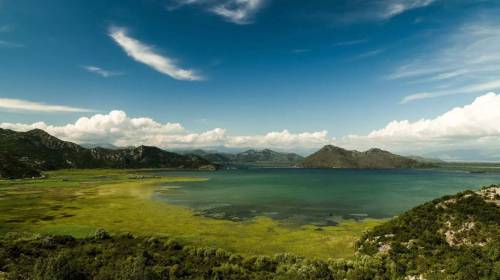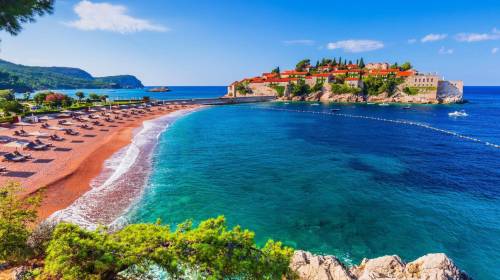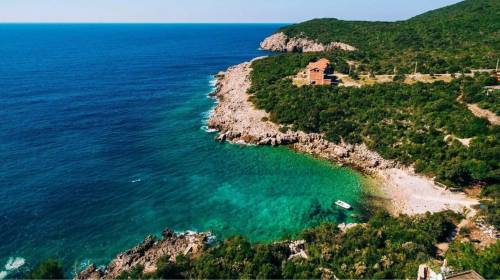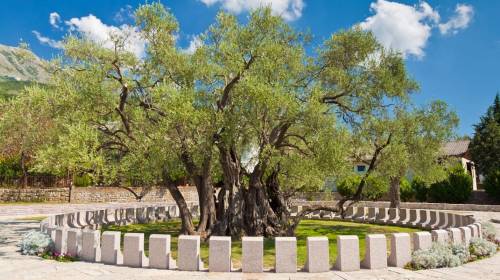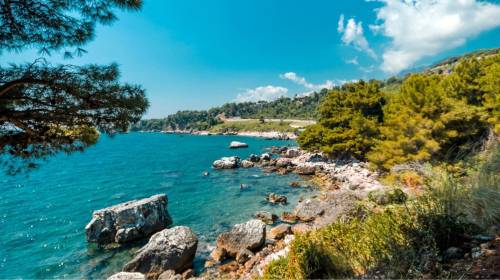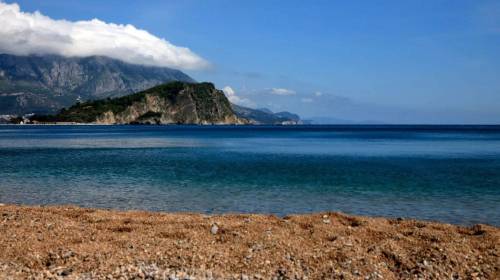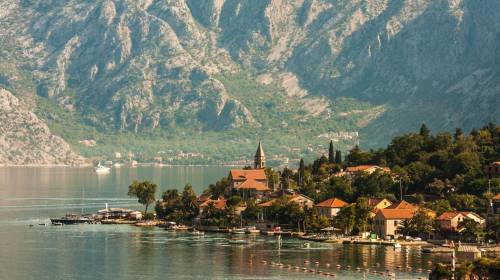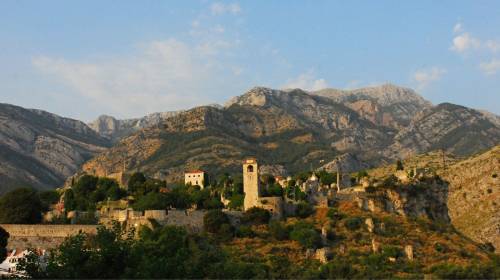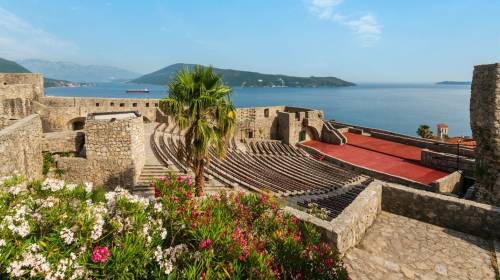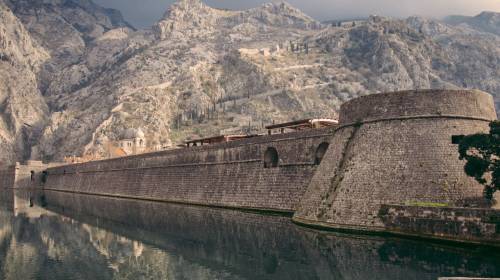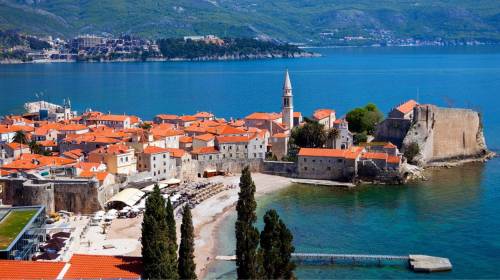Montenegro Coast: Top Destinations, Beaches and Experiences by Car
Montenegro coast combines bays, beaches, and old towns. Drive from Kotor to Ulcinj and discover hidden coves, viewpoints, and authentic local food.
The Montenegro coast stretches for almost 300 kilometers along the Adriatic Sea, and with everything it has to offer, it represents an ideal route for exploration by car. Traveling along the seaside part of this small Mediterranean country, you will experience a blend of untouched natural beauty, medieval towns, and some of the most stunning beaches in this part of Europe.
From UNESCO-protected sites, such as the Old Town of Kotor, through Budva, often called the queen of the Mediterranean, and all the way to Ulcinj with its 13-kilometer-long beach, each location will give you a completely different impression. Driving these roads allows you to easily discover hidden bays, local taverns, and spectacular viewpoints that tourists without a car often cannot reach.
Whether you want to spend just another day on a remote and peaceful sandy beach, visit ancient fortresses, or simply enjoy a calm walk along one of the many promenades, the car is the factor that gives you complete freedom of choice. That is precisely why we decided to present to you some of the most interesting locations, as well as share a few tips that will surely be useful during your adventure on the Montenegro coast.
Overview of the Montenegro Coast
As we highlighted in the introduction, the Montenegro coast stretches for almost 300 kilometers along the Adriatic Sea, offering its visitors a variety of landscapes, from fjord-like bays to narrow coastal plains. With a car, it is very easy to connect different regions in just one day, and the drive between them is often just as interesting as the destinations themselves.
Geography and Regions
The Montenegro coast is divided into six municipalities: Bar, Budva, Herceg Novi, Kotor, Tivat, and Ulcinj, each with its own unique charm. The Bay of Kotor is one of the most recognizable features, surrounded by mountains that rise up to 1,000 meters. On the other hand, travelers by car can easily reach beaches such as Jaz, Mogren, and Velika Plaža, since the main roads along the Montenegro coast run directly by the sea and often pass through smaller towns and villages.
Climate and Best Time to Visit the Montenegro Coast
The coast of Montenegro has a Mediterranean climate with hot, dry summers and mild winters, which favors a long tourist season. The best time to visit by car is from May to September, when the roads are dry and the days are long. Driving in the summer allows you to combine swimming, hiking, and exploring ancient cultural landmarks in just one route and within a single day, with sites that have stood untouched for centuries.
Cultural Influences
Because of Montenegro’s geographical position and dynamic past, the Montenegro coast has historically been influenced by different cultures. From the Venetian Republic to the Ottoman Empire, the remnants and traces of these civilizations are best seen in the architecture. Towns like Kotor, Budva, and Herceg Novi reveal their history layer by layer through fortresses, churches, old squares, and narrow stone streets, where every pavement tells its own story.
Little tip: if you decide to explore the entire Montenegro coast, we recommend starting your trip as early as possible to avoid heavy traffic, and always check your map for a few alternative routes just in case.
The Most Beautiful Destinations Along the Montenegro Coast
As already mentioned, driving along the Montenegro coast allows you to experience a lot in a short amount of time. The variety of landscapes, different types of beaches, and towns that are in some ways similar yet still unique are exactly what awaits you on your journey. Below we highlight some of the most interesting locations that should definitely be on your travel map when visiting Montenegro.
Bay of Kotor: Kotor, Herceg Novi, Tivat
The Bay of Kotor represents one of the most distinctive areas on the Montenegro coast, and in Montenegro overall. It is surrounded by steep fjords, filled with deep blue sea, and rich in cultural landmarks. Its main center is Kotor, famous for its UNESCO-protected Old Town, fortresses such as San Giovanni, and the connection to Lovćen National Park, accessible via a road with around 20 serpentines that many consider to offer the most spectacular views in Montenegro.
A bit further from Kotor lies Tivat, representing the modern side of the Montenegro coast, with one of the most luxurious marinas in Europe – Porto Montenegro, a favorite retreat of the global jet set. Not far from Tivat is the historic coastal town of Herceg Novi. It has a unique Old Town, fortresses such as Forte Mare, Kanli Kula, the Citadel, and Španjola, as well as many churches and charming spots along the shoreline that will not leave you indifferent.
What Tivat and Herceg Novi have in common is the Luštica Peninsula, which belongs partly to one municipality and partly to the other. This peninsula offers its visitors numerous hiking trails, historical Austro-Hungarian bunkers, and an authentic atmosphere that is hard to find elsewhere.
Tip: if you have the chance, make a full circle around the peninsula by car and enjoy some of the most beautiful views of the Adriatic, especially impressive at sunset.
The Budva Riviera: Budva, Petrovac, Jaz, Mogren...
Budva is the center of tourist activity, often called the capital of Montenegrin tourism, with its Old Town full of narrow streets and fortifications that preserve the spirit of past centuries. Although small, it is one of the most beautiful Old Towns on the Montenegro coast. In addition, if you drive along the Riviera, you can easily reach beaches such as Jaz and Mogren, along with many others that are less known but equally impressive.
A bit further south from Budva is Petrovac, characterized by a more relaxed atmosphere, a spacious town beach, and many popular beaches in its surroundings, all located in untouched nature. Some that you should definitely visit include Perazića Do, Buljarica, Drobni Pijesak, and Lučice.
Tip: we recommend parking outside the main streets when visiting Budva, as the town center is extremely busy in summer. This way, you can avoid traffic jams and more easily enjoy the variety of this part of the Montenegro coast.
The Southern Coast of Montenegro
On the southern part of the Montenegro coast, the first city you will encounter is Bar, an important port and trade center with a rich history and diverse cultural scene. Stari Bar, located on a hill above the town, reveals ruins and old stone streets that tell stories from times long past. In Bar, you can find numerous landmarks worth visiting, such as the Church-Mosque, the Balšić Tower, and the famous Old Olive Tree, over 2,000 years old and a true symbol of the city.
Even further south from Bar, on the very border with Albania, lies Ulcinj, known for its multicultural tradition and unique natural beauty. In addition to numerous cultural landmarks, this town also has the longest beach in Montenegro. Velika Plaža is 13 kilometers long, and driving along it is a truly special experience, with the road leading all the way to the smallest yet probably most famous island in the country – Ada Bojana.
Did you know? Driving along this part of the Montenegro coast gives you a completely different atmosphere compared to the Bay of Kotor or Budva, as here the open spaces and very wide beaches dominate the scenery.
The Best Beaches on the Montenegro Coast
We have now reached perhaps the most exciting part – the most beautiful beaches on the Montenegro coast, and how to get to them. The coast offers visitors a wide variety of options, from luxury resorts and family-friendly areas to hidden coves accessible only to those willing to explore a bit deeper. This is why having a car allows you to easily visit several different beaches in one day and find the one that suits you best.
Sveti Stefan and Queen’s Beach
Sveti Stefan is one of the most famous places on the Adriatic, recognizable for its island-resort and luxurious atmosphere. The northern part of the beach is still open to the public, with its characteristic pink pebbles and deep, clear water suitable for swimming (since the resort is not open this year, the entire beach is available to all visitors). By car, you can easily reach the parking area located near the main coastal road from Budva, so visiting this island is no problem.
Right nearby is Queen’s Beach, rightly considered one of the most beautiful on the Montenegro coast. Its location makes it fairly isolated and surrounded by forest, giving it a unique charm and much-needed tranquility. If you are traveling by car, you don’t have to worry, as despite the beach being secluded, an urban area with parking and all necessary facilities is just a five-minute walk away.
Family-Friendly and Hidden Beaches
Ploče Beach near Budva is often a favorite among families due to its pools, bars, and water activities. Because of its distance from the town center and free parking, it is easily accessible by car and offers a comfortable stay, even though it can get crowded. Still, if you enjoy an active environment, this spot will definitely suit you.
In contrast, Dobreč Beach on the Luštica Peninsula can only be reached by boat, which makes it quieter and more intimate. Surrounded by greenery and crystal-clear water, it is perfect for a day trip that combines swimming and lunch at the only restaurant there. The departure points for the boats can easily be reached by car, whether from Tivat or Herceg Novi.
Famous Resorts and Town Beaches
Mogren Beach is located right next to the Old Town of Budva. Although the tourist center is close by, the natural isolation of the beach creates a calmer atmosphere, even though crowds are not unusual. The beach is spacious and offers all necessary amenities for visitors. You can park your car near the Old Town and reach the beach on foot through a tunnel in the rocks in less than 10 minutes.
Just a bit further from Mogren, another beach in the Budva municipality deserves a spot on this list – Jaz. This wide sandy beach boasts crystal-clear water, fine and pleasant sand, and is fully equipped with all the facilities you need. What is important to highlight is that the large parking lot is located right next to the main road, which runs very close to the beach, making arrival by car extremely simple.
Practical tip: if you plan to visit several beaches in one day, start your trip early in the morning and make popular beaches such as Jaz and Mogren your first stops. This way, you can avoid the hassle of looking for parking during the busiest hours.
Activities on the Montenegro Coast
Driving along the Montenegro coast allows you to experience many activities in a relatively short amount of time. Best of all, the coast in Montenegro is positioned in such a way that it is well connected with mountains, lakes, and other natural attractions.
From Kotor, you can easily reach Lovćen National Park and visit Ivanova Korita, the village of Njeguši, as well as the famous Njegoš Mausoleum. On the other side, Lake Skadar, less than an hour’s drive from the coast, is ideal for boat trips, swimming, and of course, birdwatching in their natural habitat.
Having a car will make it significantly easier to combine these adventures with visits to towns and nearby villages, all in the same day.
Local Food and Wine
When it comes to culinary specialties you can try along the Montenegro coast, they are based on fish, olives, vegetables, and of course, local wines. In smaller towns, you can come across traditional taverns serving grilled squid, priganice (fried dough), cheese in oil, and many other authentic dishes.
For wine lovers, we suggest planning a drive to Crmnica and the surrounding villages near Lake Skadar, widely known for homemade wine and rakija. What you should know is that these destinations are not easily accessible without a car, so if you don’t have your own, we recommend renting one to fully experience what makes Montenegro truly authentic.
Practical Tips for Driving the Coast
- Parking: in Budva, Kotor, and Herceg Novi, parking in the center is limited, so we recommend using garages or private lots.
- Season: during July and August, start your routes early in the morning, when traffic is lighter and temperatures are more pleasant.
- Navigation: download an offline map, as the signal often weakens in more “remote” destinations.
- Fuel: gas stations are frequent along the main road, but not in remote parts of Luštica or near Bojana, so we recommend filling up in advance.
Mini tip: take the time to try local specialties in villages or taverns outside the main destinations – this is where the true taste of the Montenegro coast is hidden.
Distance Table Between Main Destinations on the Montenegro Coast
|
Route |
Distance |
Driving time |
Type of road |
Notes |
|
Herceg Novi – Kotor |
43 km |
55 min |
Coastal highway |
Drive through Risan and Perast, frequent delays in summer |
|
Kotor – Tivat |
9 km |
15 min |
Main road |
Fast route, congestion near Porto Montenegro |
|
Kotor – Budva |
23 km |
30 min |
Adriatic highway |
Via Trojica or through Vrmac tunnel (1.6 km) |
|
Tivat – Budva |
24 km |
25 min |
Coastal road |
Passes through Pržno and Kamenovo |
|
Budva – Sveti Stefan |
9 km |
18 min |
Adriatic highway |
Parking available along the main road |
|
Budva – Petrovac |
18 km |
28 min |
Coastal highway |
Winding road with great viewpoints |
|
Petrovac – Bar |
25 km |
25 min |
E80/E851 |
Relatively flat road |
|
Bar – Ulcinj |
26 km |
30 min |
E851 |
Good road through Možura |
|
Ulcinj – Velika Plaža |
5 km |
15 min |
Local road |
Asphalted road to the beach |
|
Velika Plaža – Ada Bojana |
15 km |
15 min |
Coastal road |
Drive along the beach |
|
Kotor – Lovćen (Cetinje) |
32 km |
45 min |
Serpentines (25 hairpins) |
Steep climb, caution required |
|
Budva – Cetinje |
33 km |
25 min |
M2.3 |
Hilly route, good main road |
|
Tivat – Luštica (Plavi horizonti) |
15 km |
35 min |
Local roads |
Narrow asphalt roads, summer traffic |
|
Herceg Novi – Luštica (Mirište) |
23 km |
35 min |
Regional road |
Narrow roads, slower driving in summer |
Final Stop – but Also a New Beginning of Exploration
Now that you know what makes the coast of Montenegro so special, it is easy to connect natural beauty, historic towns, and rich culture into a single journey. From lively rivieras and hidden beaches to national parks and authentic cuisine, diversity is what sets this coast apart among Adriatic destinations.
All that is left is to choose your route and start planning your trip. And the best way to fully experience the Montenegro coast is by traveling by car, which gives you the freedom to combine all these experiences into one unique and unforgettable whole.
Frequently Asked Questions
What are the best destinations to visit on the Montenegro coast?
The Bay of Kotor, Budva, and Herceg Novi attract the most attention, but each offers a different type of experience. Kotor is perfect for history lovers, Budva for those who want a mix of beaches and nightlife, while Herceg Novi provides a calmer pace and a rich cultural scene.
How long is the Montenegro coast?
The Montenegro coast is just under 300 kilometers long, making it compact enough to explore in a few days. However, thanks to winding roads and scenic landscapes, traveling takes longer than the length suggests – which is also part of its charm.
What are the most notable towns on the Montenegro coast?
The most notable towns are Kotor, Budva, Tivat, and Bar, each offering a different blend of tradition and urban life. Driving between them reveals the port of Bar, luxury marinas in Tivat, medieval walls in Kotor, and popular beaches in Budva.
Where are the best beaches located?
Some of the best beaches are Jaz and Mogren near Budva, Sveti Stefan, and Velika Plaža in Ulcinj. Each offers something unique – from peaceful coves and luxury resorts to kilometers of sandy stretches.
What is the best way to explore the coast – by car or other transport?
The most efficient and interesting way is by car, since public transport only covers main routes and is not always reliable. A car gives you the freedom to combine famous towns and remote beaches in a single day, with the added possibility of stopping at viewpoints you would otherwise miss.
Is it safe to drive along the Montenegro coast?
Yes, driving along the coast is safe, but it requires caution because roads can be narrow and winding. In summer, traffic is heavier, so it is best to travel early in the morning or later in the afternoon. Foreign visitors usually only need a valid national driving license, and signs are bilingual, which makes navigation much easier.
